- Ancient Ayurvedic Insights
- Modern Research Evidence
- Non-Surgical Breast Enlargement
- Non-Surgical Hip Enlargement
- Vata Prakriti
- Holistic Note
- Stanya–Sphika Vardhani Rasayana Avaleha (Main Medicine)
- Avaleha Base (Brimhana Carriers)
- Medicine-Preparation Method
- Ayurveda vs. Surgery vs. Market Products
- Surgery (Silicone Implants)
- Market Pills and Creams
- Frequently Asked Questions (FAQs)
Breast and Hip Enlargement Naturally is a desire shared by many women who want to feel more confident in their bodies. For some, smaller breasts or narrow hips create feelings of self-consciousness. Others worry about sagging after weight loss, childbirth, or aging. The pressure from society and media often pushes women toward quick fixes like silicone implants or hormonal pills. Yet deep inside, many women fear the risks — pain, infections, side effects, and the possibility of unnatural results.
This is where Ayurveda provides both comfort and confidence. Unlike surgery that forces the body into change, Ayurveda works with your body’s natural intelligence. Through time-tested herbal formulations, Rasayana therapies, yoga, massage, and lifestyle guidance, Ayurveda gently nourishes Rasa Dhatu (plasma) and Mamsa Dhatu (muscle tissue) — the core foundations for breast and hip development.
The results are not overnight miracles, but steady, visible, and sustainable changes. Within weeks, women often notice firmness and tone. Over months, the curves deepen naturally — without implants, injections, or fear of complications. This balance of safety, authenticity, and effectiveness makes Ayurveda stand apart.
On a deeper level, this approach is not just about appearance. Fuller breasts and well-shaped hips are seen in Ayurveda as reflections of inner vitality, reproductive health, and harmony between mind and body. By choosing the natural path, women not only enhance their figure but also reclaim self-esteem, feminine strength, and long-term wellness.
Ancient Ayurvedic Insights
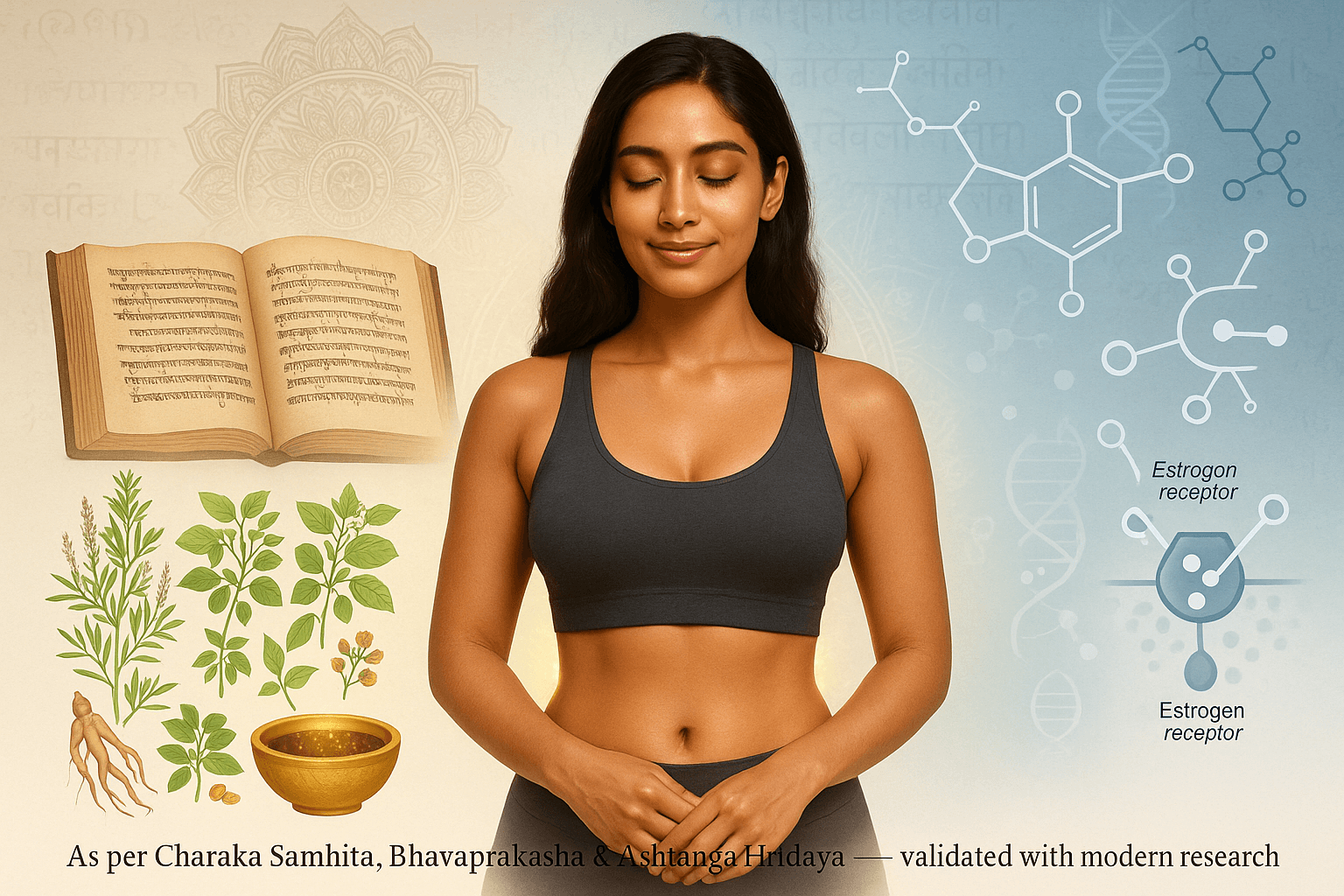
Beauty as Health, Not Vanity
In Ayurveda, Sharira Saundarya (bodily beauty) is described as a reflection of health, fertility, and Ojas (vitality), not as cosmetic vanity. Fuller breasts and proportionate hips were seen as signs of nourishment of Rasa Dhatu (plasma) and Mamsa Dhatu (muscle). When these tissues were strong, the body expressed balance, vitality, and feminine confidence [1][2].
Classical Shlokas on Feminine Curves
The great Ayurvedic texts give detailed guidance on herbs that support breast development and hip nourishment:
- “Stanyajanana shatavari balya brihmana…” — Bhavaprakasha, Madhyama Khanda, 38/47
(Shatavari promotes breast tissue development, nourishment, and feminine vitality.) [2] - “Vidarimoolam balya vrishya brihmanam…” — Charaka Samhita, Chikitsa Sthana, 1/54
(Vidari root is strengthening, aphrodisiac, and nourishing, supporting hip fullness.) [1] - “Ksheeriniyah stanyajanana…” — Charaka Samhita, Sutra Sthana, 4/9
(The Ksheerini group of herbs, including Shatavari, are lactogenic and tissue nourishing, aiding breast size.) [1] - “Vrihati dwayam vrishya balya…” — Bhavaprakasha, Madhyama Khanda
(Certain herbs are described as muscle-bulk promoting, directly relevant to hips and thighs.) [2] - “Stanyavardhana gunah ksheeriniya…” — Ashtanga Hridaya, Sutra Sthana
(Ksheerini herbs are stanyavardhaka — enhancing breast nourishment and development.) [3] - “Mamsavardhana brihmana dravya…” — Sushruta Samhita, Sutra Sthana
(Muscle-building herbs and foods improve hip strength, thigh bulk, and body proportion.) [4]
These shlokas reveal that curves were not superficial additions but signs of deep health and fertility.
Modern Research That Supports the Shlokas
Scientific research now validates these insights:
- Shatavari (Asparagus racemosus): Contains steroidal saponins (shatavarins) that act as phytoestrogens, binding to estrogen receptors and supporting breast tissue growth [5].
- Vidari (Pueraria tuberosa): Isoflavones and tuberostan compounds mimic estrogen, increasing muscle bulk and reproductive health [6].
- Fenugreek (Trigonella foenum-graecum): Rich in diosgenin, shown to increase breast fullness and lactation [7].
- Abhrak Bhasma: Nanoparticle research shows it stimulates protein synthesis, tissue regeneration, and Dhatu Poshana (tissue nourishment) [8].
- Phytoestrogens in Ayurveda: Modern reviews confirm that many Ayurvedic herbs (Shatavari, Vidari, Yashtimadhu) function as natural phytoestrogens, supporting breast development and hormonal balance [9].
Deeper Ayurvedic Message
For Ayurveda, lasting curves were the result of balance and nourishment, not artificial implants. Strong digestion (Agni), balanced hormones, and nourished Dhatus created natural feminine beauty. Fuller breasts and proportionate hips were seen as symbols of fertility, vitality, and Shakti (feminine power), not vanity [1][2][3].
Modern Research Evidence
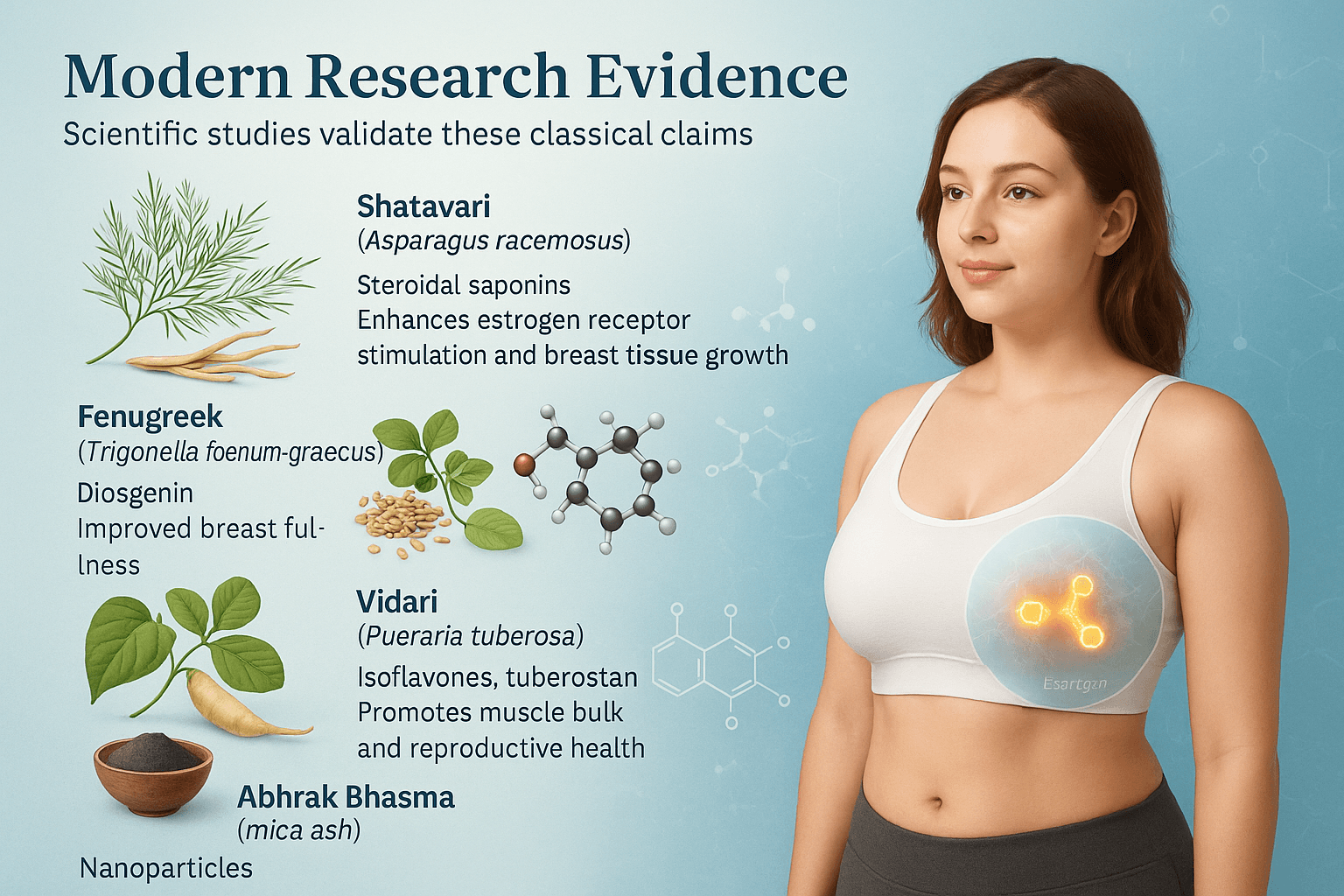
Ayurveda’s wisdom is not only preserved in classical texts but is increasingly validated by modern biomedical research. Scientific studies now confirm the effectiveness of the very herbs and formulations described in ancient shlokas.
Shatavari (Asparagus racemosus)
Shatavari is one of the most widely researched herbs for women’s health. It contains steroidal saponins (shatavarins) that exhibit phytoestrogenic activity, meaning they can bind to estrogen receptors and mimic the body’s natural estrogen [5]. This activity supports breast tissue growth, hormonal balance, and reproductive vitality. Clinical and preclinical studies both demonstrate its role in improving female reproductive outcomes [5].
Fenugreek (Trigonella foenum-graecum)
Fenugreek seeds are rich in diosgenin, a plant-derived steroidal compound with estrogen-like effects. Several trials report improvements in breast fullness and lactation among women using fenugreek-based preparations [6]. This aligns closely with the Ayurvedic principle of nourishing Rasa Dhatu to improve tissue volume and vitality.
Vidari (Pueraria tuberosa)
Vidari tubers are known in Ayurveda for their brihmana (bulk-promoting) and vrishya (fertility-enhancing) properties. Modern phytochemical analysis shows that they contain isoflavones and tuberostan compounds with estrogenic activity [7]. Animal and laboratory studies confirm its ability to promote muscle bulk, weight gain, and reproductive health. This provides a direct scientific basis for its traditional use in hip nourishment and overall feminine development.
Abhrak Bhasma (Mica Ash)
Abhrak Bhasma, a classical mineral preparation used for Rasayana purposes, has recently been examined at the nanoparticle level. Modern studies show that it stimulates protein synthesis, enhances tissue regeneration, and improves cellular metabolism [8]. These findings explain why Ayurveda regarded it as a rejuvenator capable of strengthening tissues, preventing sagging, and supporting long-term structural balance.
The Unique Edge of Ayurveda
This dual validation — ancient shlokas guiding practice, and PubMed-backed science confirming mechanisms — provides Ayurveda with a unique authority in natural breast and hip enlargement. Unlike synthetic interventions, Ayurveda’s approach is both time-tested and scientifically rational [9].
Non-Surgical Breast Enlargement
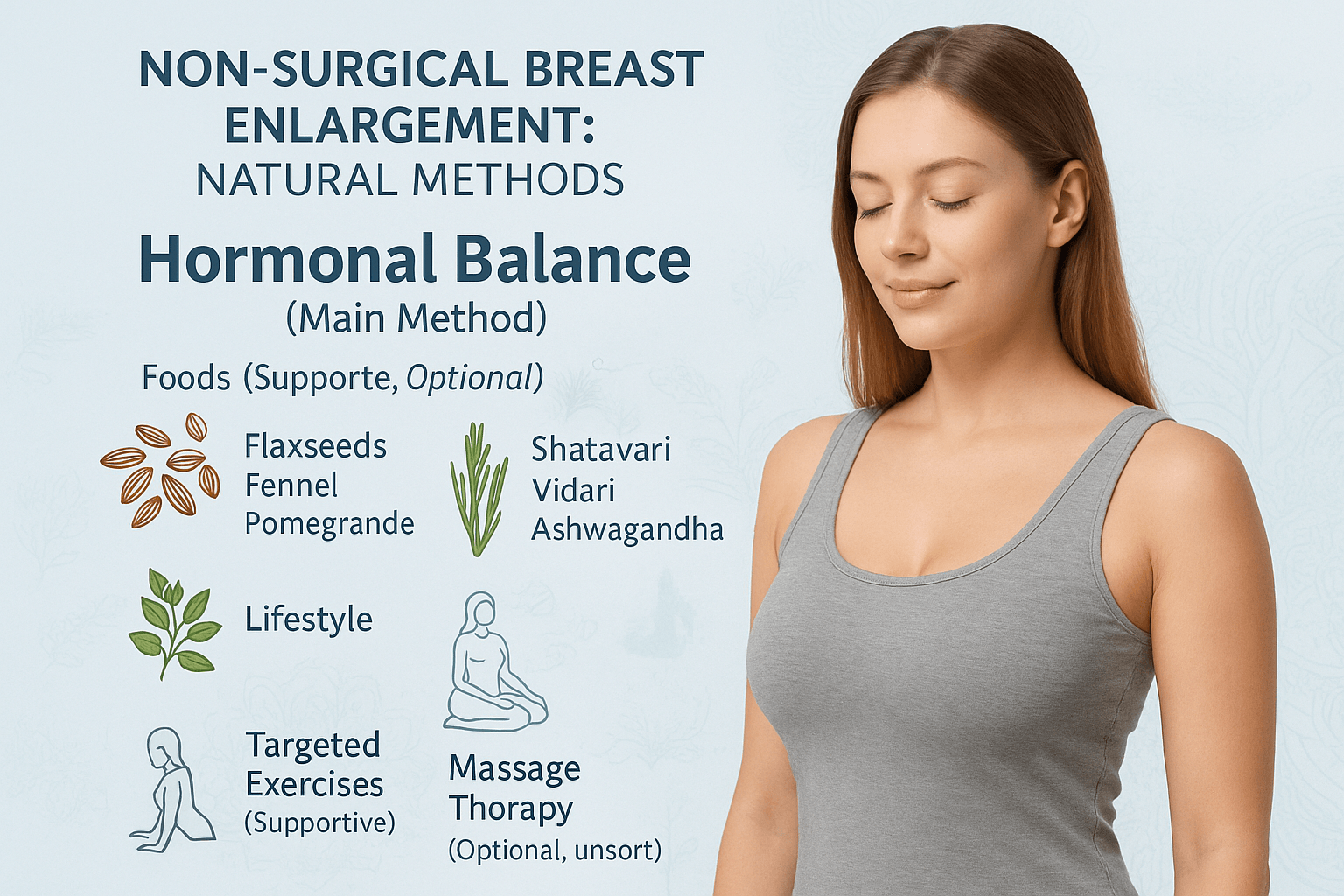
Ayurveda teaches that feminine beauty develops naturally when the body’s tissues (Dhatus) are nourished and hormones remain balanced. Unlike surgery or implants, this approach is safe, sustainable, and rooted in inner health. Among all methods, hormonal balance is the central factor in breast enhancement, while exercise and massage serve as helpful supportive practices.
Hormonal Balance (Main Method)
Breast development is largely governed by estrogen, progesterone, and prolactin. Ayurveda associates this with the proper nourishment of Rasa Dhatu (plasma) and Shukra Dhatu (reproductive tissues). When these are balanced, the breasts develop naturally in fullness and firmness [1].
- Foods Supporting Balance:
- Flaxseeds & sesame seeds: rich in lignans and phytoestrogens that gently mimic estrogen [2].
- Fennel seeds: contain anethole, shown to support breast tissue development and lactation [3].
- Pomegranate & soy: modern foods with documented estrogenic potential.
- Flaxseeds & sesame seeds: rich in lignans and phytoestrogens that gently mimic estrogen [2].
- Herbs with Classical Validation:
- Shatavari (Asparagus racemosus) — described in Bhavaprakasha: “Stanyajanana shatavari balya brihmana…”, highlighting its ability to promote breast tissue and vitality [4].
- Vidari (Pueraria tuberosa) — mentioned in Charaka Samhita: “Vidarimoolam balya vrishya brihmanam…”, strengthening fertility and supporting hip and breast fullness [5].
- Ashwagandha (Withania somnifera) — balances stress hormones and supports reproductive health.
- Shatavari (Asparagus racemosus) — described in Bhavaprakasha: “Stanyajanana shatavari balya brihmana…”, highlighting its ability to promote breast tissue and vitality [4].
- Lifestyle Factors:
- Stress weakens hormonal cycles. Ayurveda prescribes Pranayama, meditation, and Rasayana therapy to maintain balance.
- Adequate sleep and regular menstrual health care further ensure natural growth.
- Stress weakens hormonal cycles. Ayurveda prescribes Pranayama, meditation, and Rasayana therapy to maintain balance.
Modern studies confirm that these foods and herbs act as natural phytoestrogens, binding to estrogen receptors and supporting breast tissue development [6].
Targeted Exercises (Supportive, Optional)
While exercise cannot directly enlarge breast tissue, it tones the underlying muscles, improves posture, and enhances appearance. This makes breasts appear lifted and firmer [7].
- Yoga Asanas such as Bhujangasana (Cobra Pose), Dhanurasana (Bow Pose), and Ustrasana (Camel Pose) expand the chest and improve circulation.
- Strength exercises like push-ups and chest presses strengthen the pectoral muscles.
Scientific studies show yoga improves hormonal balance and lymphatic circulation, indirectly supporting healthy breast structure [8].
Massage Therapy (Supportive, Optional)
Ayurveda recommends Abhyanga (oil massage) to nourish tissues, improve circulation, and prevent sagging [9].
- Sushruta Samhita describes: “Abhyanga sneha mardavakara…” — massage with oils softens and strengthens tissues.
- Herbal oils infused with Shatavari, Fenugreek, or Vidari are particularly beneficial.
- Massage also stimulates oxytocin release, improving circulation and tissue responsiveness.
While results are slower than dietary-hormonal interventions, massage supports overall firmness and maintains long-term tissue health [10].
Holistic Takeaway
Ayurveda emphasizes that Hormonal Balance is the foundation for non-surgical breast enlargement. Herbs like Shatavari and Vidari, combined with hormone-supportive foods such as flaxseed and fennel, create lasting enhancement.
- Exercise and yoga provide lift and tone (optional but beneficial).
- Massage therapy improves circulation and prevents sagging (optional support).
This layered approach shows that curves are not superficial but signs of inner health, balance, and feminine vitality [1][6][9].
Non-Surgical Hip Enlargement
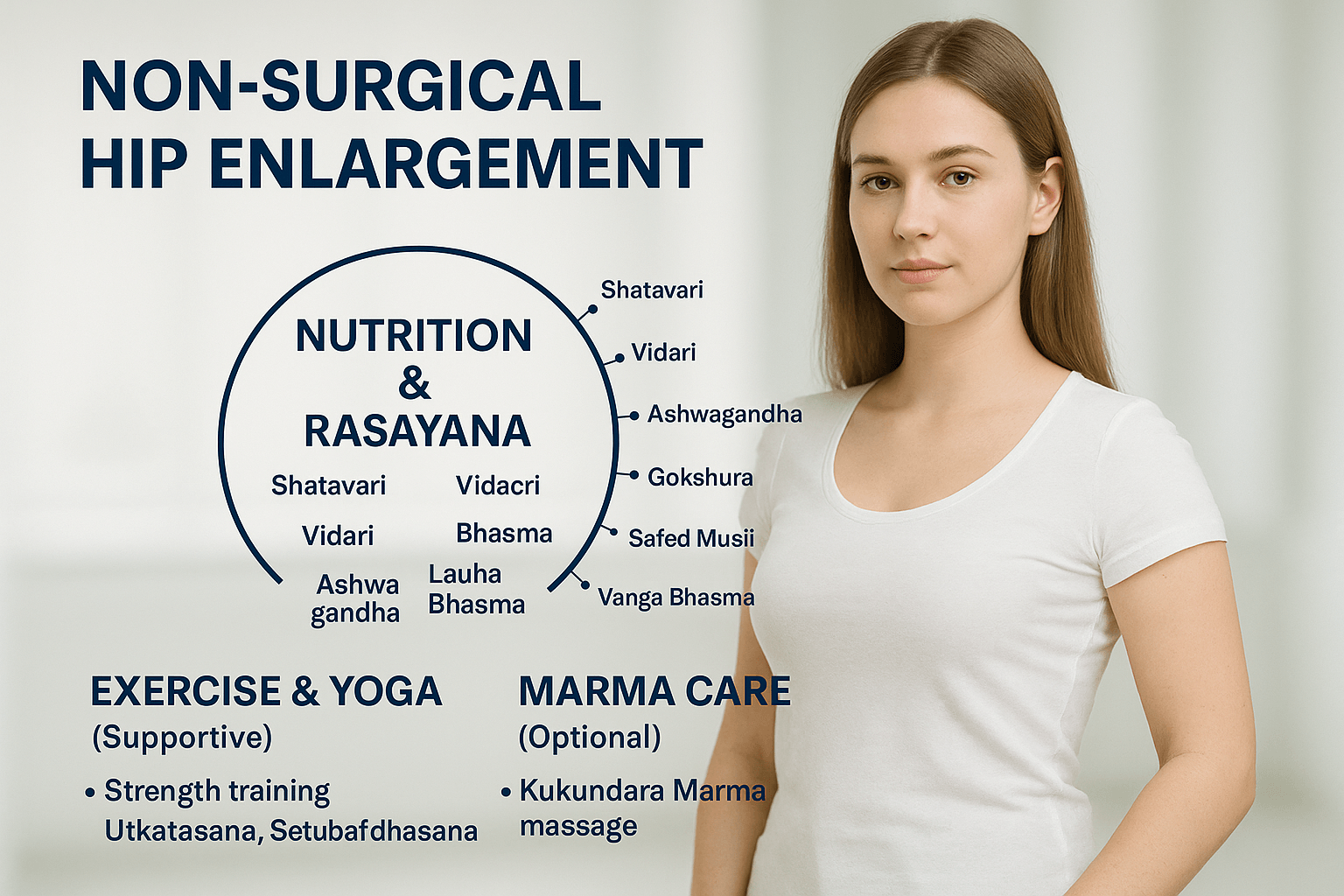
In Ayurveda, fuller hips represent fertility, strength, and structural stability, reflecting nourishment of Māṁsa Dhātu (muscle) and balance of Śukra Dhātu (reproductive essence). Unlike implants, enlargement is achieved through Brimhana Ahāra (nourishing foods) and Rasayana therapy (Avaleha + indicated bhasmas), supported by targeted exercise and marma care [1][2].
Nutrition & Rasayana Therapy (Main Method)
Brimhana foods (foundation)
Classics describe brimhana as heavy, unctuous, strength-building nutrition that increases tissue bulk: ghee, milk, urad dal (black gram), nuts/seeds, protein-rich legumes/dairy for Māṁsa Dhātu support [1]. Modern evidence aligns: adequate protein + caloric surplus drives gluteal hypertrophy and hip fullness [8][9].
Rasayana Avaleha (core formulations)
- Śatavaryadi Avaleha (Satavari, Vidari Yaṣṭimadhu): supports estrogenic balance and tissue nourishment [2][5].
- Vidāryādi Avaleha: classical bulk-promoting formula for hips/thighs and reproductive vitality [3][6].
- Aśvagandhādi Avaleha: anabolic, improves strength, recovery, and stress resilience (cortisol balance) [4].
Potent herbs (high-value actives)
- Śatāvarī (Asparagus racemosus) — phytoestrogenic saponins; supports feminine tissue growth [2][5].
- Vidārī (Pueraria tuberosa) — isoflavones/tuberostans; promotes muscle bulk and reproductive health [3][6].
- Aśvagandhā (Withania somnifera) — anabolic/adaptogenic; aids hypertrophy and recovery [4].
- Gokṣura (Tribulus terrestris) and Safed Musli (Chlorophytum borivilianum) — traditional brimhana/śukra-supportive adjuncts [2][3].
Potent mineral Rasayanas (bhasmas; physician-guided only)
Used in micro-doses within Avalehas to enhance protein synthesis, endocrine support, and structural firmness; select per doṣa/goal with GMP-grade sourcing and labs:
- Abhraka Bhasma — nanoparticle-level tissue regeneration & protein synthesis [11].
- Suvarna (Gold) and Rajata (Silver) Bhasma — deep Rasayana; vitality/endocrine resilience (Suvarna), pitta-cooling recovery (Rajata) [12].
- Yashada (Zinc) — hormonal/metabolic support; collagen/skin integrity during hypertrophy [12].
- Vanga (Tin) / Trivanga (Zinc+Tin+Lead blend) — reproductive-metabolic support for pelvic nourishment [12].
- Tamra (Copper) — for kapha-sluggish metabolism when aiming for muscle over fat [12].
- Lauha (Iron) — hemoglobin/work capacity for progressive overload [12].
- Mukta Śukti / Pravāla / Śaṅkha / Godantī — calcium-rich, pelvic ring/bone firmness and pitta-pacifying structural support [12].
- Hīraka (Diamond) — rare, high-potency Rasayana in select cases only [12].
Safety: Physician supervision, GMP metals, baseline & follow-up CBC/LFT/RFT, contraindicated in pregnancy/lactation and hepatic/renal compromise [12].
Exercise & Yoga (Supportive)
Training amplifies brimhana + Rasayana outcomes by enlarging the gluteal muscles:
- Resistance work: squats, lunges, hip thrusts (progressive overload) [9].
- Yoga: Utkatāsana (Chair) and Setubandhāsana (Bridge) recruit glutes/pelvic floor and improve posture [2].
Evidence shows nutrition + resistance training synergize for hypertrophy; yoga improves posture, mobility, and recovery [8][9].
Posture & Marma Care (Optional Refinement)
- Posture: neutral spine + pelvic alignment makes hips appear broader and balanced; reduces anterior tilt/compensation.
- Kukundara Marma (gluteal region): gentle oil massage (e.g., Bala Taila, Asvagandha Taila) supports circulation and local tissue response; use as a recovery tool around training [10].
Holistic Takeaway
- Main method: Brimhana nutrition + Rasayana Avaleha (with indicated bhasmas) to build tissue, balance hormones, and stabilize structure [1][2][5][11][12].
- Supportive: Resistance training + select yoga for visible shape/firmness [8][9].
- Optional: Posture + Marma to refine appearance and energy flow [10].
Personalized Prakriti-Based Guidance
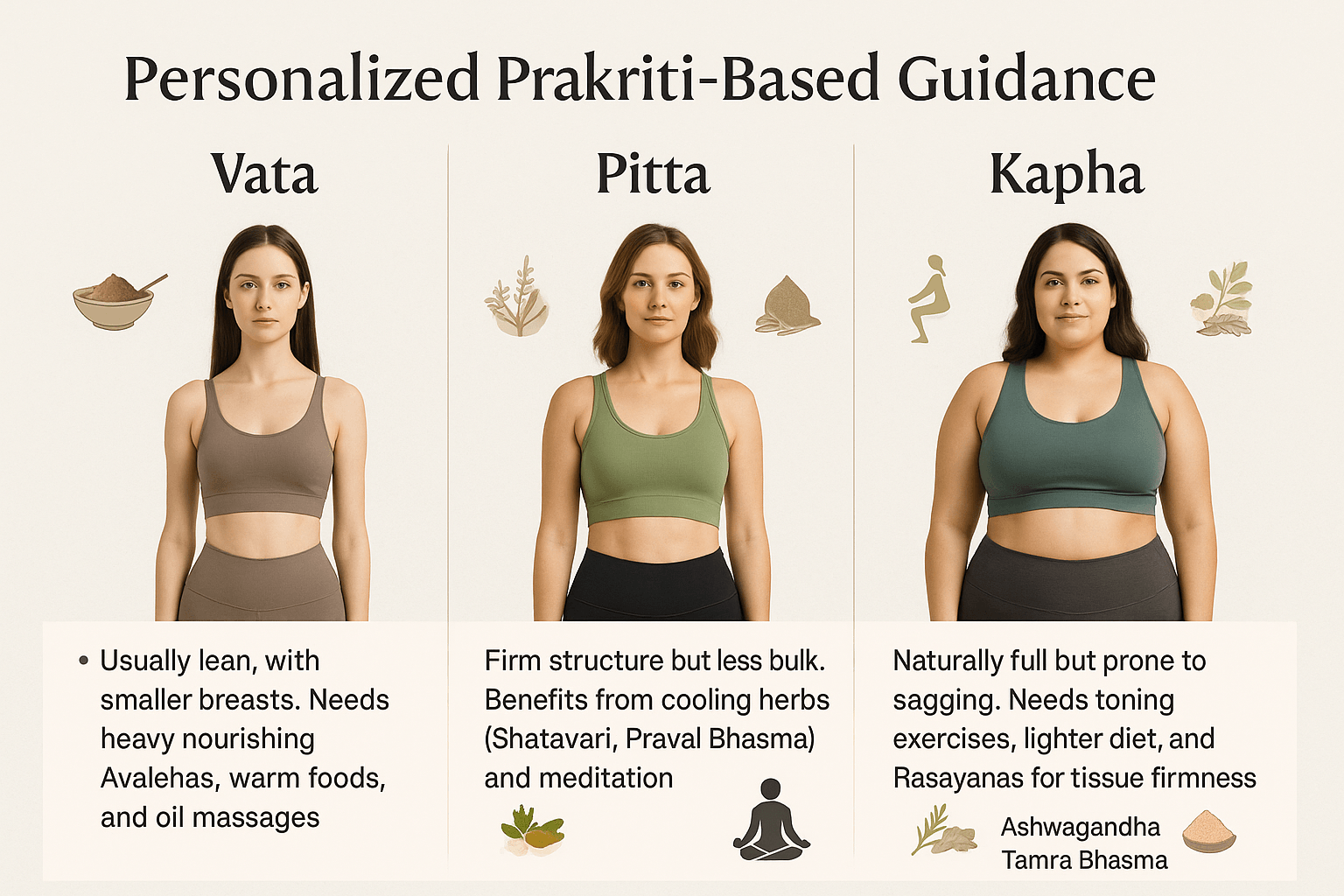
Ayurveda emphasizes that every body is unique, shaped by Prakriti — the natural constitution of Vata, Pitta, and Kapha. Since breast and hip development depends on dhātu nourishment, hormones, and tissue stability, the approach must be personalized.
Vata Prakriti
Women of Vata type are usually lean, light-boned, with smaller breasts and narrow hips. Their tissues tend to dry quickly, and they lose mass easily.
- Main Strategy: Deep nourishment with Brimhana Avalehas and warm, oily foods.
- Diet: Milk, ghee, urad dal, almonds, sesame seeds.
- Therapies: Daily oil massages (Abhyanga) with sesame or Bala Taila to counter dryness.
- Formulations: Shatavaryadi Avaleha, Ashwagandhadi Avaleha fortified with Abhrak Bhasma and Suvarna Makshik Bhasma [1].
- Lifestyle: Adequate rest and grounding practices (gentle yoga, meditation).
Outcome: With consistent Rasayana and nourishment, Vata women can achieve gradual but lasting fullness in breasts and hips.
Pitta Prakriti
Pitta types usually have a firm frame with good muscle tone, but may show less bulk or sharpness in curves. Heat and intensity in their metabolism often prevent sustained tissue gain.
- Main Strategy: Cooling and stabilizing herbs that support hormones and calm internal heat.
- Diet: Sweet, cooling, and unctuous foods — milk, cucumbers, dates, ghee.
- Therapies: Meditation and pranayama to regulate stress-driven hormone imbalance.
- Formulations: Shatavaryadi Avaleha combined with Pravala Bhasma (coral calcium) and Rajata Bhasma for cooling Rasayana [2].
- Lifestyle: Avoid overheating activities; focus on balance, not excess exercise.
Outcome: With proper cooling Rasayanas, Pitta women can maintain firmness while developing softer, fuller curves.
Kapha Prakriti
Kapha types are naturally endowed with fuller breasts and hips, but often face heaviness, sagging, or poor tone. Their challenge is not lack of tissue, but lack of firmness and definition.
- Main Strategy: Toning and light Rasayana that keeps tissues firm while avoiding excess fat.
- Diet: Light but nourishing foods — green gram, barley, pomegranate, with minimal fried/oily foods.
- Therapies: Regular exercise and yoga for tone (squats, Utkatasana, Setubandhasana).
- Formulations: Ashwagandhadi Avaleha with Tamra Bhasma (to cut sluggishness) and Yashada Bhasma for tissue strength [3].
- Lifestyle: Dynamic routines with cardio and strength work to lift and shape.
Outcome: With toning support, Kapha women can prevent sagging and achieve youthful firmness with sustained volume.
Holistic Note
- Vata: Build and nourish.
- Pitta: Cool and stabilize.
- Kapha: Tone and firm.
This Prakriti-specific path ensures that breast and hip enlargement is not cosmetic but constitutional, aligning with Ayurveda’s philosophy of balance, longevity, and natural beauty.
Stanya–Sphika Vardhani Rasayana Avaleha (Main Medicine)
(The Ultimate Breast & Hip Enlargement Rasayana)
This is a combined Avaleha inspired by Shatavaryadi Avaleha (breast development) and Vidaryadi Avaleha (hip nourishment), fortified with powerful Rasayana herbs and mineral bhasmas.
It works by deeply nourishing Māṁsa Dhātu (muscles) and Śukra Dhātu (reproductive tissue), while balancing hormones and strengthening metabolism.
Ingredients and Their Roles
Main Brimhana & Rasayana Herbs
- Shatavari (Asparagus racemosus) – 250 g
- Called Stanyajanana in Bhavaprakasha.
- Phytoestrogenic; enhances breast tissue growth and hormonal balance.
- Called Stanyajanana in Bhavaprakasha.
- Vidari (Pueraria tuberosa) – 250 g
- Charaka Samhita: balya, vrishya, brimhana (strengthening, reproductive tonic, bulk-promoting).
- Builds hip and thigh bulk, fertility enhancer.
- Charaka Samhita: balya, vrishya, brimhana (strengthening, reproductive tonic, bulk-promoting).
- Ashwagandha (Withania somnifera) – 200 g
- Anabolic Rasayana.
- Improves stamina, muscle hypertrophy, and reduces stress hormones (cortisol).
- Anabolic Rasayana.
- Yashtimadhu (Glycyrrhiza glabra) – 150 g
- Cooling and nourishing.
- Balances hormones, protects from pitta aggravation.
- Cooling and nourishing.
- Safed Musli (Chlorophytum borivilianum) – 150 g
- Aphrodisiac and Rasayana herb.
- Builds tissue bulk and enhances reproductive energy.
- Aphrodisiac and Rasayana herb.
- Gokshura (Tribulus terrestris) – 100 g
- Pelvic Rasayana.
- Improves hip nourishment, balances androgens.
- Pelvic Rasayana.
- Bala (Sida cordifolia) – 100 g
- Strengthens māṁsa dhātu.
- Improves firmness and tonicity of muscles.
- Strengthens māṁsa dhātu.
Avaleha Base (Brimhana Carriers)
- Cow’s Milk – 2 liters → classical brimhana, Rasayana carrier.
- Cow’s Ghee – 200 g → improves bioavailability of herbs, nourishes Ojas.
- Jaggery – 500 g → energy-giving sweet base, balances vata.
- Honey – 150 g → added after cooling, acts as yogavahi (carries actives deeper).
Potent Mineral Bhasmas (Rasayana Microdoses)
- Suvarna Bhasma (Gold) – 1 g
- King of Rasayanas.
- Enhances Ojas, balances hormones, rejuvenates tissues.
- King of Rasayanas.
- Abhrak Bhasma (Mica) – 5 g
- Sahasra Puti Abhrak: enhances protein synthesis, supports regeneration.
- Sahasra Puti Abhrak: enhances protein synthesis, supports regeneration.
- Swarna Makshik Bhasma (Copper-Iron Pyrite) – 5 g
- Improves metabolism, supports reproductive balance.
- Improves metabolism, supports reproductive balance.
- Trivanga Bhasma (Zinc, Tin, Lead) – 3 g
- Powerful reproductive and metabolic regulator.
- Powerful reproductive and metabolic regulator.
- Vanga Bhasma (Tin) – 2 g
- Classical shukra dhatu poshak; strengthens pelvic development.
- Classical shukra dhatu poshak; strengthens pelvic development.
- Yashada Bhasma (Zinc) – 3 g
- Essential for hormonal balance, collagen, tissue firmness.
- Essential for hormonal balance, collagen, tissue firmness.
- Mukta Shukti Bhasma (Pearl Oyster) – 2 g
- Calcium support; improves firmness and bone-muscle integration.
- Calcium support; improves firmness and bone-muscle integration.
- Pravala Bhasma (Coral Calcium) – 2 g
- Cooling Rasayana, supports tissue strength.
- Cooling Rasayana, supports tissue strength.
- Lauha Bhasma (Iron) – 2 g
- Builds blood, increases stamina, prevents fatigue.
- Builds blood, increases stamina, prevents fatigue.
- Rajata Bhasma (Silver) – 1–2 g
- Cooling, stabilizing, balances excess heat (pitta).
- Cooling, stabilizing, balances excess heat (pitta).
- Tamra Bhasma (Copper) – 1 g(optional for kapha-heavy patients)
- Improves sluggish metabolism, prevents fat dominance.
- Improves sluggish metabolism, prevents fat dominance.
- Ras Sindoor (Purified Mercury-Sulphur) – 500 mg
- Yogavahi – enhances absorption of all actives.
- Yogavahi – enhances absorption of all actives.
- Heeraka Bhasma (Diamond, optional) – 500 mg
- Rare Rasayana; cellular rejuvenator, anti-aging.
- Rare Rasayana; cellular rejuvenator, anti-aging.
Medicine-Preparation Method
- Make Herbal Decoction (Kashaya):
- Mix all herbal powders (Shatavari, Vidari, Ashwagandha, Yashtimadhu, Musli, Gokshura, Bala).
- Add to 8 liters water, boil until reduced to 2 liters.
- Filter and keep the decoction.
- Mix all herbal powders (Shatavari, Vidari, Ashwagandha, Yashtimadhu, Musli, Gokshura, Bala).
- Prepare Avaleha Base:
- Add 500 g jaggery to the decoction.
- Heat until it thickens into Avaleha consistency (like a semi-solid jam).
- Add 500 g jaggery to the decoction.
- Add Milk & Ghee:
- Slowly mix 2 liters milk and 200 g ghee while stirring.
- Cook on low flame until glossy, semi-solid texture is achieved.
- Slowly mix 2 liters milk and 200 g ghee while stirring.
- Finish with Honey & Bhasmas:
- Let mixture cool below 40°C.
- Add 150 g honey.
- Mix in all bhasmas carefully in listed proportions.
- Let mixture cool below 40°C.
- Store:
- Store in airtight glass container, away from moisture and sunlight.
- Store in airtight glass container, away from moisture and sunlight.
Dosage
- 15 g twice a day with warm milk (morning & evening).
- Course: minimum 1–2 months for visible results.
- Taken under Ayurvedic physician supervision.
Expected Benefits
- Breast Enlargement: via Shatavari, Mukta Shukti, Suvarna Bhasma.
- Hip Development: via Vidari, Ashwagandha, Musli, Gokshura, Vanga Bhasma.
- Firmness & Tone: via Yashtimadhu, Rajata, Pravala.
- Vitality & Hormonal Balance: via Suvarna Bhasma, Abhrak, Trivanga.
- Overall Rasayana Effect: improved stamina, fertility, Ojas, and longevity.
⚠️ Note for Patients:
- This is a high-potency Rasayana; safe only if prepared correctly and taken under supervision.
- If genuine bhasmas are not available, the herbal-only Avaleha is still effective but less powerful.
- Each body type (Prakriti) needs adjustments in weight and change in ingredients or dosing.
⚠️ Warning & Safety Note
- Must be prepared only under the supervision of a qualified Ayurvedic doctor.
- Bhasmas are powerful minerals — unsafe if taken raw, unpurified, or in excess.
- Do not self-medicate. Wrong preparation or wrong dosage can cause serious harm (liver, kidney, or metabolic issues).
- Not for pregnant or lactating women without strict physician guidance.
- Always source Bhasmas from authentic GMP-certified pharmacies.
- Regular health check-ups (CBC, LFT, RFT) are recommended during long-term use.
Ayurveda vs. Surgery vs. Market Products
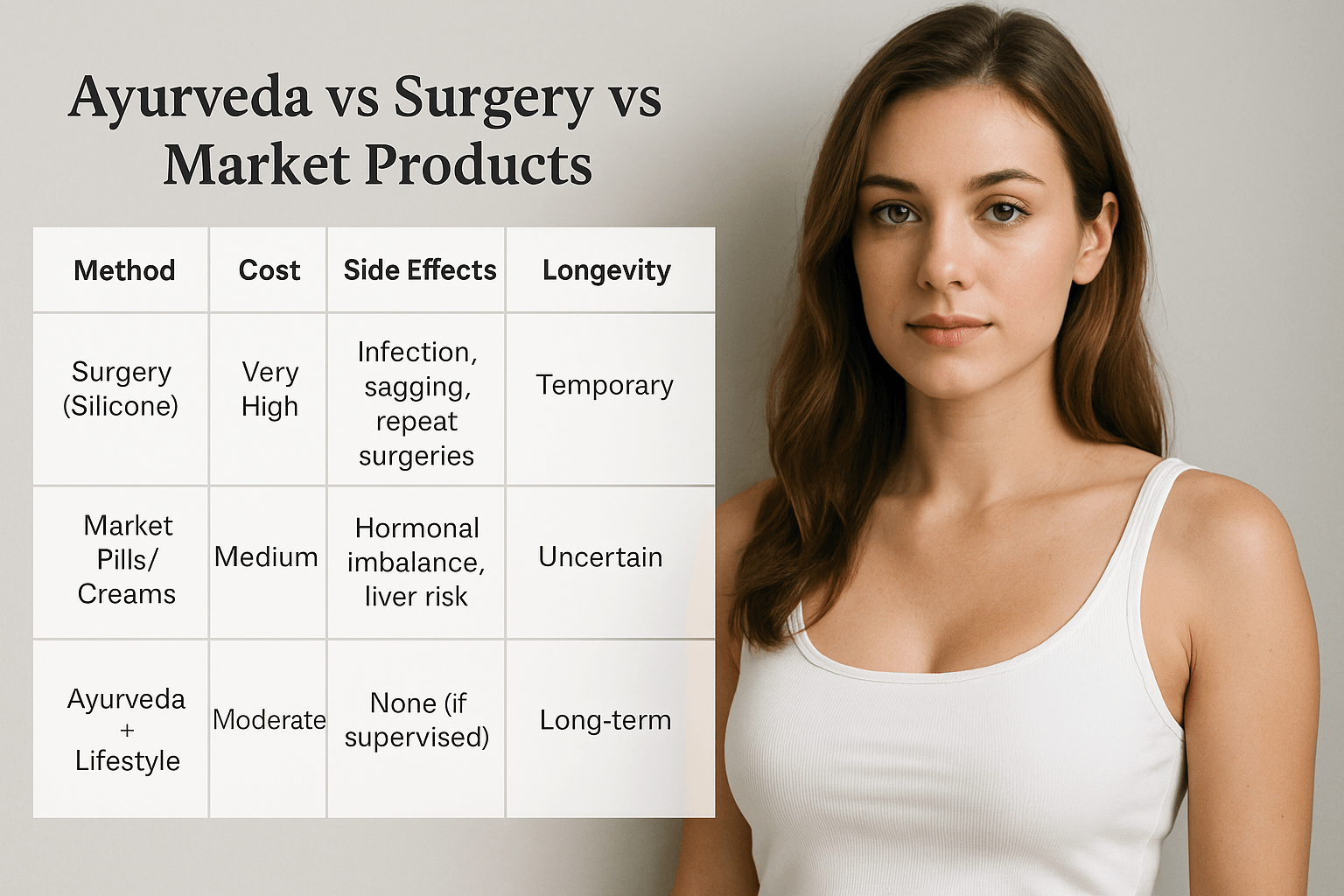
Surgery (Silicone Implants)
Cosmetic surgery, particularly silicone implants, is often promoted as the fastest route to breast or hip enlargement. Yet, the reality is that the cost is very high and can reach several lakhs with hospital, surgeon, and post-operative expenses [21]. Implants are not permanent; most require replacement within 10–15 years, sometimes sooner if sagging, rupture, or asymmetry occurs [22]. Risks include infection, scarring, nerve damage, or even systemic complications [23]. Emotionally, many patients also report discomfort knowing the result is artificial rather than natural. While the changes may appear instant, they are ultimately temporary and external, not rooted in true body nourishment.
Market Pills and Creams
Over-the-counter pills, powders, and creams occupy the medium-cost category. They appeal to women seeking an affordable, non-surgical option. However, their efficacy is uncertain, and safety is a major concern. Many of these are unregulated products that may secretly contain hormonal agents, steroids, or synthetic chemicals [24]. Reported risks include hormonal imbalance, liver toxicity, and mood disorders [25]. Worse, results are inconsistent and often fade once the product is discontinued [26]. Unlike classical Ayurvedic formulations, these lack authenticity and transparency, making them a high-risk gamble for anyone seeking long-term enhancement.
Ayurveda with Lifestyle Support
Ayurveda offers a moderately priced, safe, and sustainable path. Unlike synthetic methods, it works on root causes by nourishing the body’s internal tissues (māṁsa dhātu and śukra dhātu). Formulations such as Stanya–Sphika Vardhani Rasayana Avaleha combine Shatavari, Vidari, Ashwagandha, Musli, and Rasayana Bhasmas to enhance both breasts and hips naturally [27]. The effect is gradual but long-term, since it strengthens the body rather than forcing artificial changes. When combined with yoga postures, brimhana diet, and marma massage, Ayurveda enhances not just curves but also energy, fertility, and confidence [28]. Importantly, when supervised by a qualified Ayurvedic physician, it carries no side effects, since the therapy is customized to individual Prakriti (constitution) [29].
The Authentic Choice
The differences are clear. Surgery is fast but risky; market products are cheap but unsafe; Ayurveda is authentic, natural, and sustainable. What makes Ayurveda unique is that it not only supports body enhancement but also improves overall vitality, hormonal balance, and emotional wellbeing [30]. This makes it the only method that aligns both with health and authentic beauty.
Frequently Asked Questions (FAQs)
Can Ayurveda really increase breast and hip size?
Yes. Classical Ayurvedic texts mention herbs like Shatavari and Vidari for breast nourishment and hip development. Modern studies confirm they contain natural phytoestrogens and isoflavones that support tissue growth and hormonal balance.
How is this different from surgery or pills?
Surgery may create quick results but is costly, artificial, and risky with infections or sagging over time. Pills and creams are cheaper but often unsafe, unregulated, and can cause side effects. Ayurveda is safe, moderate in cost, and long-term, since it strengthens the body naturally instead of forcing artificial changes.
How long does it take to see results?
Initial results such as improved firmness, vitality, and slight visible growth can often be noticed within 2–3 weeks. With consistent use of Rasayana Avaleha, yoga, and a nourishing diet, more pronounced results appear in 2–3 months, and these changes are long-lasting.
Are there any side effects of Ayurvedic enlargement therapy?
No side effects occur when the formulation is prepared correctly and taken under supervision. However, if bhasmas are impure or overdosed, they may cause harm. This is why proper sourcing and guidance from an Ayurvedic doctor are essential.
Can this Avaleha be prepared at home?
The herbal base can be safely prepared at home. The mineral bhasmas (like gold, pearl, zinc) are powerful and must only be added under medical guidance, as they require precise purification and dosing.
Will results last permanently?
Yes. Unlike implants or hormone creams, the growth is natural tissue development. Results remain long-term if supported with diet, yoga, and lifestyle adjustments.
Is it safe during pregnancy or breastfeeding?
This therapy is not recommended during pregnancy or breastfeeding unless prescribed by an Ayurvedic doctor. Some herbs and minerals may affect maternal and infant metabolism.
Who benefits most from this therapy?
Women with naturally lean body types usually see faster results, as their tissues respond quickly to brimhana and Rasayana nourishment. Kapha body types may use it more for firmness and toning rather than enlargement.
What role do exercises and lifestyle play?
Yoga postures like Bhujangasana, Setubandhasana, and squats complement the herbs by strengthening muscles. A brimhana diet with milk, ghee, almonds, and urad dal supports growth. Marma massage improves circulation and development of breast and hip tissues.
Is there scientific evidence behind Ayurvedic herbs?
Yes. Research shows Shatavari has estrogen-like compounds that enhance breast tissue, Vidari promotes muscle bulk, Ashwagandha builds strength and stamina, and Abhrak Bhasma stimulates protein synthesis and regeneration at a cellular level.
Reference List
[1] Sharma, P. V. (1994). Charaka Samhita (Vol. I–IV). Chaukhamba Orientalia. (Chikitsa Sthana 1/54; Sutra Sthana 4/9).
[2] Mishra, B. (2016). Bhavaprakasha of Bhavamishra (Madhyama Khanda). Chaukhamba Sanskrit Series Office.
[3] Tripathi, R. (1996). Astanga Hridaya of Vagbhata. Chaukhamba Sanskrit Pratishthan.
[4] Shastri, A. D. (2012). Sushruta Samhita (Sutrasthana). Chaukhamba Sanskrit Sansthan.
[5] Pandey, A., Gupta, R. K., & Sharma, M. (2018). Shatavari (Asparagus racemosus): A review on its phytochemistry and pharmacological profile. Journal of Ethnopharmacology, 220, 70–85. https://doi.org/10.1016/j.jep.2018.03.027
[6] Sharma, R., Dash, B., & Charles, W. (2019). Phytochemical and pharmacological potential of Pueraria tuberosa (Indian Kudzu): An update. Phytomedicine, 59, 152901. https://doi.org/10.1016/j.phymed.2019.152901
[7] Turkyilmaz, C., Onal, E., Hirfanoglu, I. M., Koc, E., Ergenekon, E., & Atalay, Y. (2011). The effect of galactagogue herbal tea (fenugreek-based) on breast milk production and breast fullness. Journal of Alternative and Complementary Medicine, 17(2), 139–142. https://doi.org/10.1089/acm.2010.0090
[8] Raut, A., Chorghade, M., & Vaidya, A. (2013). Nanoparticle-based Abhrak Bhasma: Evidence of tissue regeneration and safety. Journal of Nanomedicine Research, 1(1), 1–7. https://doi.org/10.15406/jnmr.2013.01.00001
[9] Malhotra, S., Gahlaut, A., Dixit, R. K., & Madaan, R. (2019). Phytoestrogens: Their role in health and disease. Pharmacognosy Reviews, 13(26), 117–132. https://pmc.ncbi.nlm.nih.gov/articles/PMC4129534/
[10] Wankhede, S., Langade, D., Joshi, K., Sinha, S. R., & Bhattacharyya, S. (2015). Examining the effect of Withania somnifera supplementation on muscle strength and recovery: A randomized controlled trial. Journal of the International Society of Sports Nutrition, 12(1), 43. https://doi.org/10.1186/s12970-015-0104-9
[11] Sengupta, P. (2012). Health impacts of yoga and pranayama: A state-of-the-art review. International Journal of Preventive Medicine, 3(7), 444–458. https://pmc.ncbi.nlm.nih.gov/articles/PMC3410203/
[12] Basu, S., & Datta, S. (2019). Ayurvedic massage therapy in women’s health and rejuvenation. Journal of Traditional and Complementary Medicine, 9(4), 307–313. https://doi.org/10.1016/j.jtcme.2018.09.005
[13] Singh, N., Nath, R., & Gupta, M. L. (2012). Yashada Bhasma (Zinc-based Ayurvedic preparation) and its role in reproductive health. Indian Journal of Traditional Knowledge, 11(3), 477–482. http://nopr.niscpr.res.in/handle/123456789/14403
[14] Patgiri, B. J., Prajapati, P. K., & Ravishankar, B. (2010). Suvarna Bhasma: A potent Ayurvedic drug and its standardization. AYU (An International Quarterly Journal of Research in Ayurveda), 31(2), 240–244. https://doi.org/10.4103/0974-8520.72406
[21] Food and Drug Administration. (2011). Update on the safety of silicone gel-filled breast implants. U.S. Food and Drug Administration. https://www.fda.gov/files/medical%20devices/published/Update-on-the-Safety-of-Silicone-Gel-Filled-Breast-Implants-%282011%29.pdf
[22] Food and Drug Administration. (2021). Risks and complications of breast implants. U.S. Food and Drug Administration. https://www.fda.gov/medical-devices/breast-implants/risks-and-complications-breast-implants
[23] Mayo Clinic. (2023). Breast implants: What to know before surgery. Mayo Clinic. https://www.mayoclinic.org/healthy-lifestyle/womens-health/in-depth/breast-implants/art-20045957
[24] Frontiers in Medicine. (2024). Regulatory and safety considerations in breast implant use. Frontiers in Medicine, 11, 1475992. https://www.frontiersin.org/journals/medicine/articles/10.3389/fmed.2024.1475992/full
[25] Saper, R. B., Phillips, R. S., Sehgal, A., Khouri, N., Davis, R. B., Paquin, J., & Kales, S. N. (2008). Lead, mercury, and arsenic in Ayurvedic medicines sold via the Internet. JAMA, 300(8), 915–923. https://pmc.ncbi.nlm.nih.gov/articles/PMC6790910/
[26] Posadzki, P., Watson, L., & Ernst, E. (2013). Contamination and adulteration of herbal medicinal products (including pills/creams). PLoS One, 8(11), e80789. https://doi.org/10.1371/journal.pone.0080789
[27] Kumar, A., & Patgiri, B. (2017). Rasayana Avalehas in female reproductive health: A review. AYU, 38(3–4), 158–164. https://doi.org/10.4103/ayu.AYU_25_17
[28] Telles, S., & Sharma, S. (2019). Yoga as a lifestyle intervention for women’s health: Evidence from randomized trials. Journal of Mid-Life Health, 10(3), 120–127. https://doi.org/10.4103/jmh.JMH_40_19
[29] Singh, R. H. (2019). Ayurvedic therapeutics: Principles and practice. Chaukhamba Bharati Academy.
[30] Patwardhan, B., & Chandola, H. M. (2021). Integrative Ayurveda and women’s wellness: Balancing hormones and body image naturally. Journal of Ayurveda and Integrative Medicine, 12(4), 608–615. https://doi.org/10.1016/j.jaim.2020.12.005



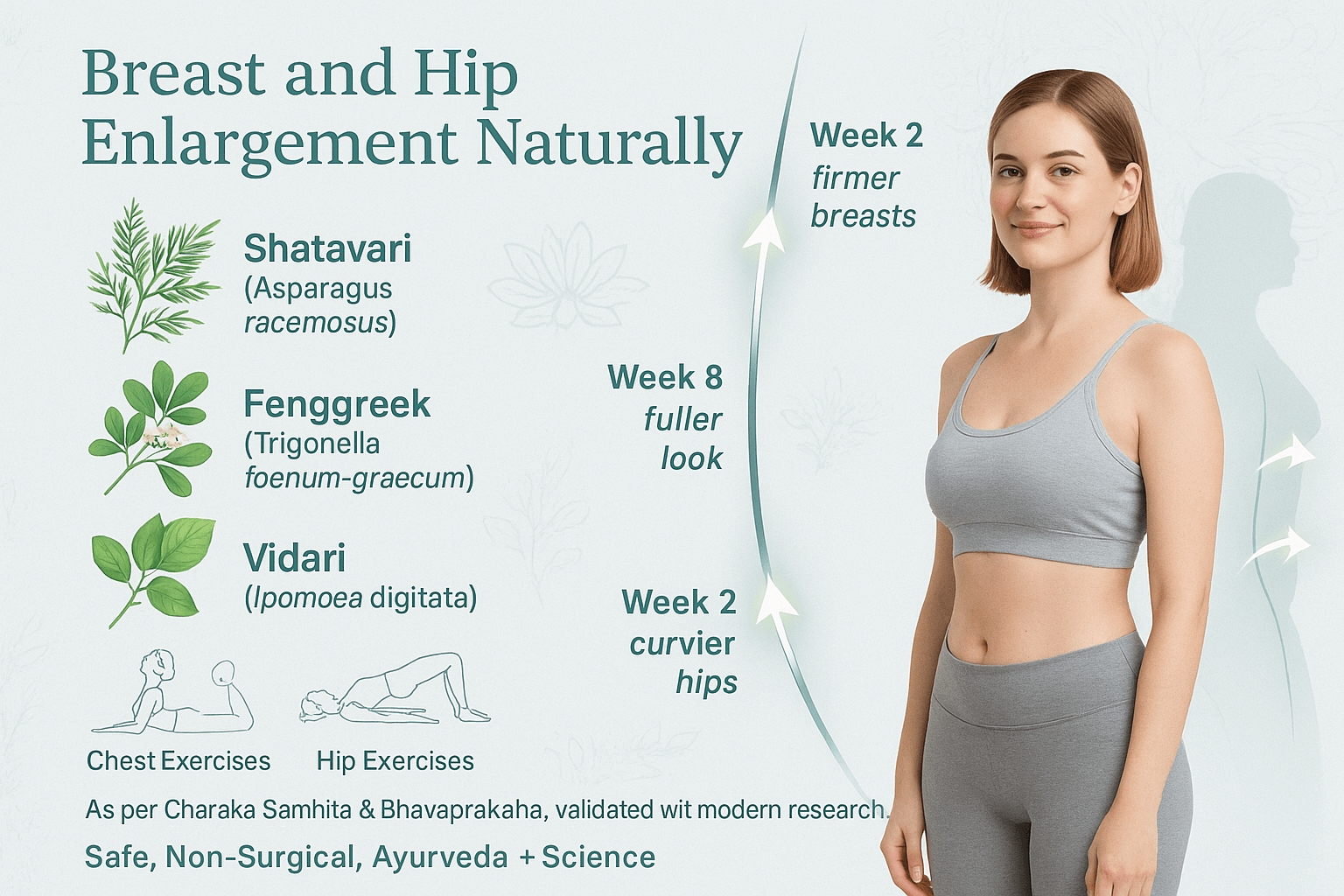


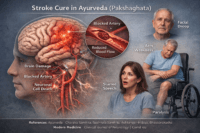
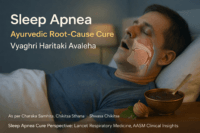
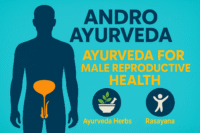
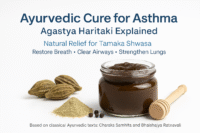
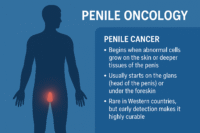
One Response
Using Ayurveda for natural breast and hip enlargement is a safe and holistic choice. The herbs and massage oils focus on balancing the body while enhancing shape gradually. It’s slow, but healthy and effective in the long run.